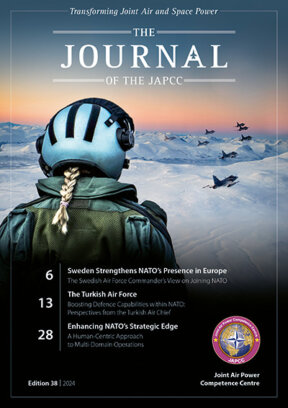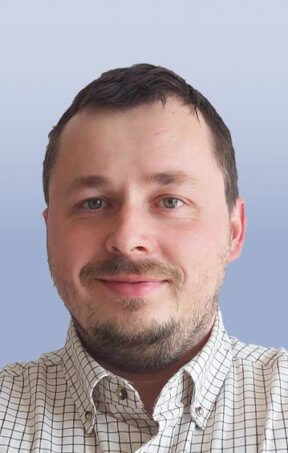Introduction
This is the third and final piece in a series on air, space, and cyber applications of Quantum Technology (QT).
The objective of the series is to disentangle the science of QT to inform strategic leaders and defence planners of realistic expectations for QT.
In the previous part, we explored quantum transducers and clocks, and introduced the promising benefits of quantum-enhanced radars. In this paper we will elaborate on quantum imaging systems for Intelligence, Surveillance, and Reconnaissance (ISR), introduce QT-enabled sensors such as gravimeters and magnetometers, and explain their benefits for Positioning, Navigation, and Timing (PNT) applications.
Since the publication of the inaugural article in the series in February 2023, which established the theoretical basis for our subsequent comprehensive discussions of their applications, QT has gained greater recognition in NATO circles. As Technology Readiness Levels (TRL) rise and advancements in quantum-powered devices progress, NATO introduced its Quantum Technology Strategy in January 2024.1 This vision considers the potential of QT to offer disruptive capabilities that, if exploited by our adversaries, could reduce the Alliance’s ability to deter and defend. In concert with other Emerging and Disruptive Technologies (EDT) such as autonomy, Artificial Intelligence (AI), and big data, QT may also constitute strategic advantage for the Alliance.
The complexity of quantum technologies is not merely reflected in the recently introduced strategy. NATO’s key enabler of capability identification, the NATO Defence Planning Process (NDPP), is at the initial stage informed by Strategic Foresight Analysis (SFA). This strategic document establishes the prognosis for the future Alliance operating and security environment and identifies that the convergence of EDTs, particularly QT and AI, will not only transform world society but will change the character of the future warfare.
Intelligence, Surveillance, and Reconnaissance
Quantum Imaging Systems
Introduction: Quantum imaging leverages the unique properties of quantum mechanics to transcend the capabilities of traditional imaging technologies. Its remarkable applications include seeing through obstacles, enhanced imaging in adverse weather conditions, and capturing images from around corners or in three dimensions. Central to quantum imaging is the use of single or entangled photons. When photons are entangled, the state of one is intrinsically linked to the other, regardless of distance. Manipulating one photon reveals information about its partner, allowing us to capture of information beyond the reach of conventional photons. This advanced imaging process involves intricate quantum optics and relies on highly sensitive detection equipment.
Advantage: The foremost advantage of quantum imaging, which commonly uses entangled photon pairs, is its superior resolution and sensitivity compared to classical methods. Excelling in low-light environments, it can penetrate mediums like fog, smoke, or certain solids, which would usually hinder traditional optical imaging. Quantum systems are adept at detecting single photons and precisely measuring their attributes, enabling detailed imaging in challenging conditions where standard cameras are ineffective.
Quantum ghost imaging is a technique that uses pairs of entangled photons to create images. One photon interacts with the object and is detected by a simple sensor, while its entangled partner is captured by a camera. The image is formed by linking the detections, even though the camera never directly sees the object. This method is more resistant to environmental interference and can produce clear images in difficult conditions, using various types of light for greater flexibility.
Another application, Quantum Light Detection and Ranging (LIDAR), offers unmatched capabilities compared to traditional LIDAR. Commercially available quantum LIDAR systems, like quantum gas LIDAR with a range of approximately 200 meters, exemplify this advancement.2 Other breakthroughs are three-dimensional quantum cameras with hundreds of meters of range, or non-line-of-sight imaging, capable of visualizing objects around corners over distances up to 1.43 km.3,4
Applications: In military contexts, quantum imaging presents a multitude of significant advantages. Its ability to see through obscurants such as smoke or foliage has obvious advantages for ISR and aviation operations. This capability ensures the delivery of clear imagery in situations where conventional systems might be ineffective. For instance, quantum imaging could prove invaluable for helicopter pilots landing in environments obscured by dust, fog, or smoke, and for long-range surveillance and target identification under challenging weather conditions.5
In the space domain, quantum LIDAR is particularly useful for observing space debris and other space assets such as satellites, enhancing situational awareness and safety in space operations.6,7
An additional intriguing defence application is to use non-linear optical materials to convert longer infrared light into near-visible light.8 This conversion allows detection with conventional, cost-effective, high-performance silicon-based cameras, which is particularly relevant for applications like night vision.
Time Expectations: Quantum imaging is among the more mature quantum technologies, with a few commercial products already available, such as quantum LIDAR for gas leak detection. The development of military-grade quantum imaging systems is progressing, focusing on enhancing robustness and real-world applicability. Overcoming challenges in miniaturization and improving photon production rate and detection efficiency will be key to integrating these advanced systems into military operations in more than five years.
Quantum Magnetometry
Introduction: Quantum magnetometry utilizes quantum principles and systems to measure magnetic fields with exceptional precision, surpassing classical magnetometers. Central to quantum magnetometry are the quantum properties of particles, such as spin states, which are highly sensitive to magnetic fields. This technology finds applications in various fields, from medical imaging like MRI, to geophysical exploration, and archaeological surveys.
For magnetic sensing, various approaches can be used, such as Superconducting Quantum Interference Devices (SQUIDs), Nitrogen Vacancy (NV) centres in diamonds, and Optically Pumped Magnetometers (OPMs). These technologies exploit quantum interference in superconducting loops, the sensitivity of electron spins, or changes in light polarization to detect magnetic fields.
Advantage: Quantum magnetometers outperform classical magnetometers in sensitivity, accuracy, spatial resolution, and range. SQUIDs can measure fields as low as a few femtoteslas. NV centres, operating at room temperature, provide high spatial resolution and can detect fields in the nanotesla range. OPMs balance sensitivity and practicality, often reaching femtotesla sensitivities. In comparison, classical magnetometers like fluxgate magnetometers typically have sensitivities in the range of 1 to 10 picoteslas and spatial resolutions from millimetres to centimetres. NV centres and OPMs can achieve nanoscale spatial resolution and do not require cryogenic cooling, making them ideal for compact applications, such as advanced brain function measurements in magnetoencephalography (MEG).9
Applications: In military applications, quantum magnetometers’ sensitivity and precision are invaluable. Quantum magnetometers can help with extending of situational awareness, enabling visualizing, tracking, and classifying of objects that are underground.10 They can detect submarines’ subtle magnetic signatures from airborne platforms at distances of several kilometers, significantly farther than classical magnetometers.11 This capability extends to detecting camouflaged weapons and military systems or standoff weapon detection12 and to mine detection.13
Other significant applications include non-destructive corrosion detection in aircraft and microelectronic assurance in evaluating the integrity of integrated circuits, for example, sensing hardware trojans in microchips that are critical for military systems across all domains.14 Quantum magnetometers are also expected to be used for space surveillance and weather measurement.
Time Expectations: The field of quantum magnetometry is rapidly evolving. While SQUIDs offer unmatched sensitivity, their requirement for cryogenic temperatures and the need for reduced Size, Weight, and Power (SWaP) limit some applications. NV centres and OPMs, being more adaptable for field deployment, are closer to broader deployment. For example, a portable NV-based magnetometer has already been demonstrated.15 In the coming years, we can expect to see more advanced and miniaturized versions of these technologies being integrated into military systems, enhancing capabilities in surveillance, navigation, and reconnaissance.
Quantum Gravimetry
Introduction: Quantum gravimetry uses quantum principles to achieve highly precise measurements of gravitational fields. The key technology here is cold-atom interferometry, where ultra-cold atoms are used as highly accurate sensors. In a typical quantum gravimeter, a cloud of these atoms is released, and their fall is measured with laser pulses. The wave-like nature of the atoms creates an interference pattern, allowing for extremely precise measurements of gravitational acceleration. Additionally, new technologies in this field, such as superconducting devices and sensors using entangled atoms, are expanding the possibilities of quantum gravimetry.
These advanced quantum instruments are not limited to a single application, their potential spans across geophysical exploration, navigation, and even the detection of subterranean structures or resources. In geophysics, for instance, they offer detailed insights into natural subsurface structures, assisting in the exploration of minerals or hydrocarbons.
Advantage: Quantum gravimeters have a distinct edge over classical gravimeters in terms of sensitivity and precision. For example, cold atom gravimeters have achieved sensitivities within tens of micro-gals, surpassing classical gravimeters which typically measure gravitational acceleration with an accuracy of hundreds of micro-gals. This heightened sensitivity allows quantum gravimeters to detect minute changes in gravitational fields, which classical instruments might miss. Furthermore, quantum gravimeters are less susceptible to environmental noise, enabling absolute measurements of gravitational acceleration and gradiometry. Quantum gradiometers can detect variations over smaller spatial scales, making them very useful for applications like detecting underground cavities or monitoring geological changes. Additionally, quantum gravimeters are known for their long-term stability and low drift rate, reinforcing their reliability.
Applications: The exceptional sensitivity and accuracy of quantum gravimetry and gradiometry have significant implications for military applications. They can be instrumental in detailed subterranean mapping, aiding military operations in uncovering underground bunkers, tunnels, or concealed facilities, particularly in regions where direct surveillance is impractical. In naval contexts, quantum gravimeters enhance the detection of submerged entities like submarines, with their sensitivity aiding identification of large underwater metallic objects. Beyond these, quantum gravimetry can bolster geophysical ISR efforts. They can detect minute changes in the gravitational field, potentially revealing the presence of heavy military equipment or landscape modifications due to enemy activities. Absolute quantum gravimetry has already been tested from airborne platforms.16
Time Expectations: Quantum gravimetry is a rapidly evolving field. Currently, cold atom gravimeters are predominantly experimental and in the prototype phase, with a recent significant advancement being the successful demonstration of trapped neutral atoms in a compact device placed on a drone, paving the way for future integration of gravimetry sensing capabilities.17 Within the next 3 to 8 years, we can anticipate the emergence of practical, deployable quantum gravimeters for scientific and industrial purposes. Their incorporation into military technology to enhance mapping, navigation, and surveillance capabilities is likely to soon follow. The speed at which these technologies are adopted into military applications hinges on ongoing advancements in miniaturization, robustness, and operational versatility in various environments.
Positioning, Navigation and Timing (PNT)
Gravity and Magnetic-Aided Navigation
Introduction and Applications: Quantum sensors are revolutionizing gravity and magnetic-aided navigation (map-matching), offering robust alternatives to GPS, especially in environments where GPS signals are unavailable. Magnetic-anomaly aided navigation, for instance, leverages detailed maps of Earth’s magnetic field, which exhibits geographically unique and immutable patterns, for precise location estimation, crucial in areas like underwater navigation. Similarly, gravity-aided navigation employs quantum technology to accurately measure Earth’s gravitational field, providing precise geolocation information. These quantum technologies, as detailed in the ISR section, have potential in areas where conventional navigation systems fall short.
Time Expectation: The deployment of gravity and magnetic-aided navigation systems is contingent on the availability of comprehensive gravity and magnetic field maps of Earth, because these navigation systems will be most impactful when sufficiently detailed anomaly maps are available. A recent breakthrough involves SandboxAQ’s AQNav, a near-commercial quantum magnetometry-aided navigation solution that the USAF successfully tested on various aircraft to demonstrate its potential for real-time, unjammable navigation.18
Quantum Inertial Navigation
Introduction: Quantum inertial navigation, employing principles akin to those in quantum gravimetry, represents a significant advancement in navigation technology. This method uses quantum accelerometers and gyroscopes, harnessing the behavior of super-cooled atoms or ions. These systems precisely measure the quantum properties of particles, including their wave functions and responses to movement, allowing for accurate determination of position and orientation. In comparison, mechanical or optical inertial navigation systems drift over time, typically up to one nautical mile per hour. Quantum inertial navigation systems are expected to reduce this drift just a few meters per hour.
Applications: The potential applications of quantum inertial navigation, particularly in miniaturized forms suitable for airborne systems like aircraft or missiles, are vast. This technology is independent of external signals like GPS or sensors such as radar or infrared guiding, and is not vulnerable to electronic warfare countermeasures. Furthermore, it shows promise as a primary navigation system in future space exploration and presence.
Time Expectations: Quantum inertial navigation components are currently undergoing testing in relevant environments, including aboard ships and aircraft. An intermediate step might involve hybrid systems combining quantum and classical sensors, offering incremental yet significant advantages.19 Overall, the timeline for fully operational quantum inertial navigation systems parallels that of quantum gravimetry, with similar developmental milestones and challenges anticipated.
Discussion
The quantum technologies discussed, along with their applications and use cases, represent a selection of the most promising research and development for military use in the near-to-medium term. Notably, many of these technologies are undergoing testing in relevant environments. Concurrently, there have been significant strides in supporting technologies, such as laser and vacuum chamber miniaturization and advances in integrated photonics, which can contribute to reductions in SWaP, potentially lowering overall cost.
AI is another important supporting technology, as it plays a significant role in analyzing and interpreting data from quantum sensing systems. For example, the AQNav system utilizes AI to precisely compare local measurements with global magnetic field maps, enabling accurate location estimation. AI algorithms enhance the signal-to-noise ratio, filtering out environmental and mechanical noise, and ensuring precise and reliable data interpretation. This integration of AI with quantum sensing technologies not only improves accuracy but also accelerates the processing of complex data, making these systems more efficient and effective for various applications.
NATO has increasingly focused on supporting military-oriented quantum technology through various initiatives. For instance, quantum-related activities now make up a significant portion of Research Task Groups (RTGs), where specific scientific research and technology development challenges are addressed. Additionally, NATO’s Defence Innovation Accelerator for the North Atlantic (DIANA) and the NATO Innovation Fund provide significant support to startups and SMEs. These programs aim to integrate innovative ideas into NATO’s strategic framework, promoting the development of dual-use technologies that benefit both military and civilian sectors.
Furthermore, it is important to recognize that many leading defence contractors are actively involved in quantum technology research, with a particular emphasis on quantum sensing. Their development efforts are likely more advanced, especially regarding testing in relevant environments, compared to academic research. This involvement by major defence entities indicates a robust and growing interest in leveraging quantum technologies for enhanced military capabilities. NATO’s DIANA accelerators play a crucial role here by also supporting small startups, ensuring that innovative solutions from smaller enterprises can be developed and integrated, thereby transforming defence capabilities in the coming years.
Conclusions and Key Takeaways
The exploration of quantum technologies in this paper underscores their growing role and huge potential in the military domain, particularly in air and space operations. The advancements in quantum sensing and metrology, quantum communication, and quantum computing can offer a significant paradigm shift, offering capabilities far beyond the scope of current technologies. With quantum sensors already showing high levels of technological readiness, their application in diverse and challenging military environments appears close. These advancements are not just theoretical; practical demonstrations in real-world scenarios aboard ships, aircraft, and drones highlight the transition of these technologies from laboratory settings to operational fields.
The following paragraphs present the principal recommendations from the QT article series:
- Sound understanding of QT is crucial for the defence planners and senior leaders to establish informed requirement, resourcing, and programmatic decisions. Their expert perspective is pivotal in interaction with industry and science to clearly define the defence technology demands.
- In order to foster the Quantum-Ready Alliance Strategy, nations should seek to accelerate innovations and development in the QT field and focus on those that are most impactful in augmenting NATO capabilities. Furthermore, given the dual-use nature of QT, their strategic potential can only be fully utilized through a deeper collaboration between Allies and their technology and science organizations.
- Converging EDTs will likely have an unprecedented impact on society in the coming 20 years, but will also change the character of warfare and the quality of military capabilities. QT and AI together constitute a potential capability to support NATOs future warfighting concept, which will require an increased level of autonomy, automated decision-supporting tools, and high-fidelity sensors.
As QT technologies continue to evolve and mature, they are likely to redefine the landscape of defence technology, including the air and space domains, in the near future. NATO may leverage the potential of QT and transform it into a strategic advantage to ensure that it fulfils its core tasks of collective defence and deterrence.













